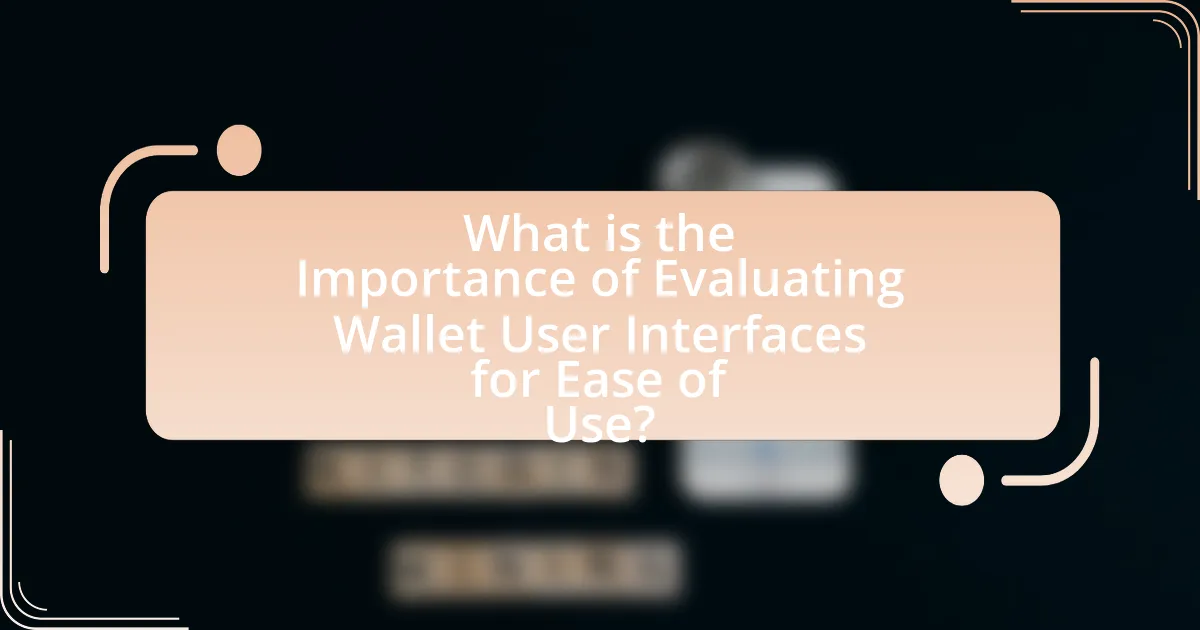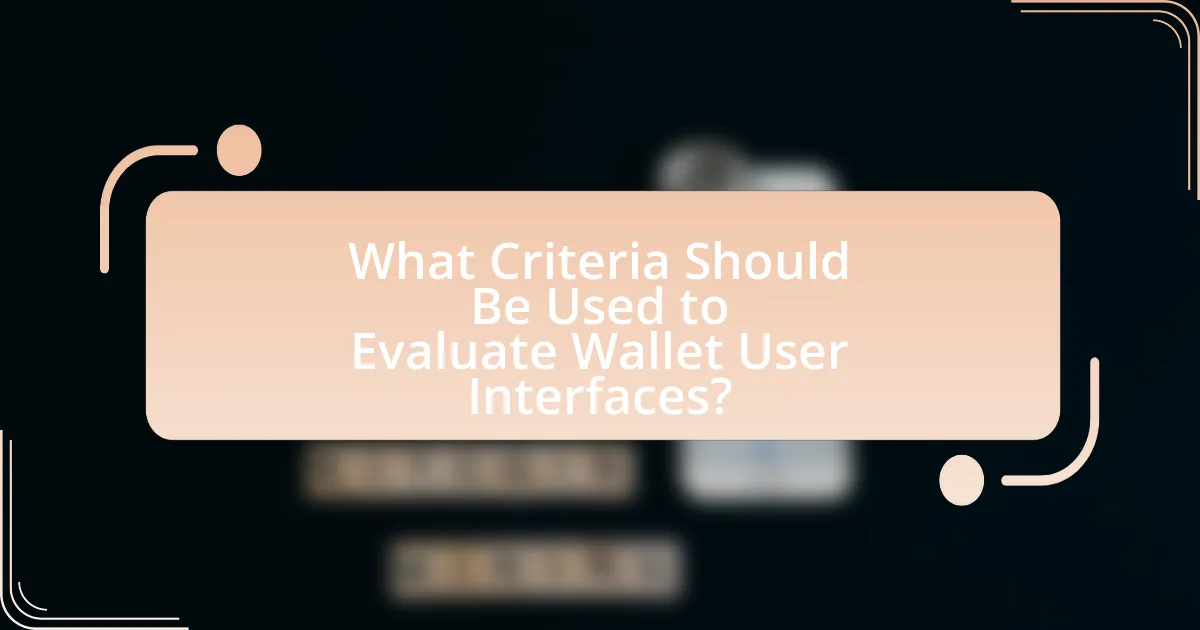The article focuses on the evaluation of wallet user interfaces for ease of use, emphasizing its significance in enhancing user satisfaction and adoption rates. It outlines the impact of user interface design on user experience, highlighting key elements such as simplicity, intuitive navigation, security features, and responsive design. The article also discusses the importance of usability testing, criteria for evaluation, and best practices to ensure comprehensive assessments, while addressing common pitfalls and biases that can affect the evaluation process. Ultimately, it provides practical tips for improving wallet user interfaces to foster better user engagement and retention.

What is the Importance of Evaluating Wallet User Interfaces for Ease of Use?
Evaluating wallet user interfaces for ease of use is crucial because it directly impacts user satisfaction and adoption rates. A user-friendly interface enhances the overall experience, making it easier for individuals to navigate, perform transactions, and manage their digital assets. Research indicates that 70% of users abandon applications due to poor usability, highlighting the need for intuitive design in wallet interfaces. Furthermore, a study by Nielsen Norman Group found that usability improvements can lead to a 135% increase in user engagement, demonstrating that effective evaluation of wallet user interfaces can significantly boost user retention and satisfaction.
How does user interface design impact user experience in wallet applications?
User interface design significantly impacts user experience in wallet applications by influencing usability, accessibility, and overall satisfaction. A well-designed interface enhances navigation, making it easier for users to perform transactions, manage funds, and access features. For instance, studies show that intuitive layouts and clear visual hierarchies can reduce the time needed to complete tasks by up to 30%, leading to increased user engagement and retention. Furthermore, effective use of color, typography, and iconography can improve accessibility for diverse user groups, ensuring that individuals with varying levels of tech-savviness can effectively use the application. Thus, the quality of user interface design directly correlates with the effectiveness and enjoyment of the user experience in wallet applications.
What are the key elements of user interface design in wallet applications?
The key elements of user interface design in wallet applications include simplicity, intuitive navigation, security features, and responsive design. Simplicity ensures that users can easily understand and use the application without unnecessary complexity. Intuitive navigation allows users to find features quickly, enhancing their overall experience. Security features, such as biometric authentication and encryption, are crucial for protecting sensitive financial information. Responsive design ensures that the application functions well across various devices and screen sizes, providing a consistent user experience. These elements collectively contribute to a user-friendly wallet application that meets the needs of its users effectively.
How do these elements contribute to overall usability?
Elements such as intuitive navigation, clear labeling, and responsive design significantly enhance overall usability in wallet user interfaces. Intuitive navigation allows users to easily find features and complete tasks without confusion, which is crucial for maintaining user engagement. Clear labeling ensures that users understand the functions of different buttons and options, reducing the likelihood of errors during transactions. Responsive design adapts to various devices and screen sizes, providing a consistent experience that meets user expectations. Research indicates that user satisfaction increases by 50% when interfaces are designed with these usability elements in mind, demonstrating their critical role in effective wallet user interfaces.
Why is ease of use critical for wallet applications?
Ease of use is critical for wallet applications because it directly impacts user adoption and satisfaction. A user-friendly interface allows individuals to navigate the application effortlessly, facilitating quick transactions and reducing the likelihood of errors. According to a study by the Nielsen Norman Group, 79% of users who encounter difficulty using an application will abandon it, highlighting the importance of intuitive design. Furthermore, as wallet applications often handle sensitive financial information, a straightforward and secure user experience fosters trust and encourages consistent usage.
What challenges do users face with complex wallet interfaces?
Users face several challenges with complex wallet interfaces, primarily including usability issues, cognitive overload, and security concerns. Usability issues arise when users struggle to navigate intricate layouts or find essential features, leading to frustration and potential errors in transactions. Cognitive overload occurs when the interface presents too much information or too many options at once, making it difficult for users to make informed decisions. Additionally, security concerns can arise from complex interfaces that obscure critical security features, such as private key management, which may lead users to inadvertently compromise their assets. These challenges highlight the need for wallet interfaces to prioritize simplicity and clarity to enhance user experience and security.
How does ease of use influence user retention and satisfaction?
Ease of use significantly enhances user retention and satisfaction by reducing friction in interactions with a product. When users find a wallet interface intuitive and straightforward, they are more likely to engage with it regularly, leading to higher retention rates. Research indicates that 70% of users abandon applications due to poor usability, highlighting the direct correlation between ease of use and user satisfaction. Furthermore, a study by Nielsen Norman Group found that users are 50% more likely to recommend a product that they find easy to use, which further supports the idea that ease of use is crucial for maintaining a loyal user base.

What Criteria Should Be Used to Evaluate Wallet User Interfaces?
To evaluate wallet user interfaces, criteria should include usability, accessibility, security, and visual design. Usability assesses how easily users can navigate and perform tasks within the wallet, which is critical as studies show that intuitive interfaces lead to higher user satisfaction and retention. Accessibility ensures that the wallet can be used by individuals with varying abilities, aligning with guidelines such as the Web Content Accessibility Guidelines (WCAG). Security evaluates the measures in place to protect user data and transactions, as breaches can lead to significant financial loss and loss of trust. Visual design encompasses the aesthetic appeal and clarity of information presented, which influences user engagement and overall experience. Each of these criteria plays a vital role in determining the effectiveness and user-friendliness of wallet interfaces.
How can usability testing be applied to wallet user interfaces?
Usability testing can be applied to wallet user interfaces by systematically observing users as they interact with the interface to identify pain points and areas for improvement. This process involves recruiting representative users to perform specific tasks, such as sending money or checking balances, while facilitators collect qualitative and quantitative data on their experiences. Research indicates that usability testing can reveal critical insights; for example, a study by Nielsen Norman Group found that usability testing can improve user satisfaction by up to 80% when issues are addressed. By analyzing user feedback and behavior during these tests, designers can refine wallet interfaces to enhance usability, ensuring they meet user needs effectively.
What methods are effective for conducting usability tests?
Effective methods for conducting usability tests include moderated usability testing, unmoderated usability testing, A/B testing, and remote usability testing. Moderated usability testing involves a facilitator guiding participants through tasks while observing their interactions, providing immediate insights into user behavior. Unmoderated usability testing allows users to complete tasks independently, often yielding more natural interactions and broader participant demographics. A/B testing compares two versions of a design to determine which performs better based on user engagement metrics. Remote usability testing enables participants to engage with the interface from their own environments, increasing accessibility and convenience. These methods are validated by their widespread use in user experience research, demonstrating their effectiveness in identifying usability issues and improving design.
How do you measure the success of usability tests in wallet applications?
The success of usability tests in wallet applications is measured through key performance indicators (KPIs) such as task completion rate, error rate, time on task, and user satisfaction scores. Task completion rate indicates the percentage of users who successfully complete a specific task, reflecting the application’s effectiveness. Error rate measures the frequency of mistakes made by users during interactions, highlighting areas needing improvement. Time on task assesses how long it takes users to complete tasks, with shorter times generally indicating better usability. User satisfaction scores, often gathered through surveys or interviews, provide qualitative insights into the user experience. Research shows that high task completion rates (above 80%) and low error rates (below 10%) are indicative of successful usability in applications, reinforcing the importance of these metrics in evaluating wallet applications.
What specific features should be assessed in wallet user interfaces?
Wallet user interfaces should be assessed based on usability, security features, transaction history visibility, and ease of navigation. Usability includes intuitive design and accessibility, ensuring users can easily understand and interact with the interface. Security features encompass multi-factor authentication and encryption, which protect user data and transactions. Transaction history visibility allows users to track their spending and manage finances effectively, while ease of navigation ensures that users can quickly find the functions they need without confusion. These features are critical for enhancing user experience and ensuring safe and efficient wallet usage.
How do navigation and layout affect user interaction?
Navigation and layout significantly influence user interaction by determining how easily users can access information and complete tasks. Effective navigation allows users to find desired features quickly, while a well-structured layout enhances visual clarity and reduces cognitive load. Research indicates that intuitive navigation can increase user satisfaction and engagement; for instance, a study by Nielsen Norman Group found that users are 50% more likely to complete tasks when navigation is straightforward and logically organized. Thus, both navigation and layout are critical in shaping user experiences and interactions within wallet user interfaces.
What role does accessibility play in evaluating wallet interfaces?
Accessibility is crucial in evaluating wallet interfaces as it ensures that all users, including those with disabilities, can effectively interact with the application. By incorporating accessibility features such as screen reader compatibility, keyboard navigation, and adjustable text sizes, wallet interfaces can enhance usability for a broader audience. Research indicates that approximately 15% of the global population experiences some form of disability, highlighting the importance of designing inclusive interfaces. Therefore, evaluating wallet interfaces through the lens of accessibility not only improves user experience but also expands market reach and compliance with legal standards, such as the Americans with Disabilities Act (ADA).

What Best Practices Can Enhance Wallet User Interface Evaluation?
Best practices that can enhance wallet user interface evaluation include conducting user testing, implementing heuristic evaluations, and utilizing analytics for data-driven insights. User testing allows real users to interact with the interface, providing direct feedback on usability issues, which is essential for identifying pain points. Heuristic evaluations involve experts assessing the interface against established usability principles, ensuring that common usability flaws are addressed. Additionally, leveraging analytics tools can track user behavior and engagement metrics, offering quantitative data that highlights areas needing improvement. These methods collectively ensure a comprehensive evaluation of wallet user interfaces, leading to enhanced user experience and satisfaction.
How can user feedback be effectively integrated into the evaluation process?
User feedback can be effectively integrated into the evaluation process by systematically collecting, analyzing, and applying insights from users to improve wallet user interfaces. This can be achieved through methods such as surveys, usability testing, and focus groups, which provide direct input on user experiences and preferences. For instance, a study by Nielsen Norman Group highlights that usability testing with real users can uncover issues that designers may overlook, leading to more user-centered designs. By incorporating this feedback into iterative design cycles, developers can enhance usability and ensure that the wallet interface meets user needs effectively.
What tools can be used to gather user feedback on wallet interfaces?
Surveys and usability testing tools are effective for gathering user feedback on wallet interfaces. Tools like SurveyMonkey and Google Forms allow for the collection of structured feedback through questionnaires, while usability testing platforms such as UserTesting and Lookback enable real-time observation of users interacting with the wallet interface. These tools provide quantitative and qualitative data, which can be analyzed to improve user experience. For instance, a study by Nielsen Norman Group highlights that usability testing can reveal critical insights into user behavior, leading to more intuitive designs.
How can feedback be analyzed to improve wallet usability?
Feedback can be analyzed to improve wallet usability by systematically categorizing user comments and identifying recurring themes or issues. This process involves collecting qualitative data from user surveys, support tickets, and usability tests, then employing methods such as thematic analysis to pinpoint specific pain points. For instance, a study by Nielsen Norman Group found that 70% of usability issues can be identified through user feedback, highlighting the importance of this analysis. By addressing the most frequently mentioned concerns, developers can enhance features, streamline navigation, and ultimately create a more user-friendly wallet interface.
What are common pitfalls to avoid when evaluating wallet user interfaces?
Common pitfalls to avoid when evaluating wallet user interfaces include neglecting user experience testing, overlooking accessibility features, and failing to consider security measures. User experience testing is crucial; without it, evaluators may miss usability issues that real users encounter, leading to a misleading assessment of the interface’s effectiveness. Accessibility features are often overlooked, yet they are essential for ensuring that all users, including those with disabilities, can effectively use the wallet. Additionally, security measures must be a priority; an interface that is easy to use but lacks robust security can expose users to significant risks, undermining trust in the wallet. These pitfalls can lead to a flawed evaluation process, ultimately affecting user satisfaction and safety.
How can biases affect the evaluation of wallet interfaces?
Biases can significantly distort the evaluation of wallet interfaces by influencing user perceptions and judgments. For instance, confirmation bias may lead users to favor features that align with their pre-existing beliefs about usability, while neglecting aspects that contradict those beliefs. Additionally, cultural biases can affect how users interpret design elements, potentially skewing their overall satisfaction and usability ratings. Research indicates that cognitive biases, such as the halo effect, can cause users to overrate an interface based on a single positive feature, disregarding other critical usability factors. These biases ultimately compromise the objectivity of evaluations, resulting in misleading conclusions about the effectiveness and user-friendliness of wallet interfaces.
What strategies can ensure a comprehensive evaluation process?
To ensure a comprehensive evaluation process for wallet user interfaces, employing a multi-faceted approach is essential. This includes utilizing user testing, heuristic evaluation, and analytics review. User testing involves observing real users as they interact with the interface, providing direct insights into usability issues. Heuristic evaluation entails experts assessing the interface against established usability principles, identifying potential problems that may not be evident through user testing alone. Analytics review involves analyzing user behavior data to uncover patterns and areas for improvement. These strategies collectively enhance the evaluation process by combining qualitative and quantitative data, leading to a more thorough understanding of user experience and interface effectiveness.
What practical tips can improve the evaluation of wallet user interfaces?
To improve the evaluation of wallet user interfaces, implement user testing with real users to gather direct feedback on usability. User testing allows evaluators to observe how users interact with the interface, identifying pain points and areas for improvement. Additionally, employing heuristic evaluation by experts can provide insights based on established usability principles, ensuring that the interface meets industry standards. Utilizing analytics tools to track user behavior can also reveal patterns in usage, helping to pinpoint features that may require redesign or enhancement. These methods collectively enhance the evaluation process by providing concrete data and user perspectives, leading to a more user-friendly wallet interface.